RETINAL DEGENERATIONS
Retinal degenerations are a large group of diseases. Macular degenerations involve the tiny central area of the retina that we read with. That area is called macula. There are several different types of macular degeneration. The most common type is the so called 'dry' macular degeneration, where the central retina disappears as small patches or as one slowly growing solitary area.
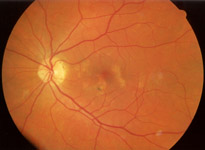
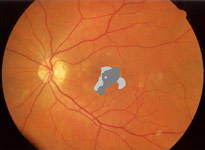
Fig.16a. Changes in the macula may look very small. In the visual field examination there are losses in the very centre of the field: dark grey patch in the picture to the right means severe loss of function and the light grey patches somewhat less severe loss of function. Because of these changes the person uses retinal functions around the central retina to read texts. The person sees still nearly normally in the minute area in the center of the visual field marked with a light grey dot and therefore has "normal central acuity" but the area is too small to allow reading, only one letter at a time can be read with it.
At the places, where the retinal layers have disappeared, also choroidal structures have vanished and bare sclera is visible behind the largest choroidal vessels. If its function becomes disturbed it is still possible to read with the retina surrounding the macula. Because the surrounding retina does not see as well as does the macula, a person with macular degeneration has to use larger texts or magnify the text with a magnifying lens or strong reading glasses. If still greater magnification is needed it is possible to use a TV- reading aid, CCTV (closed circuit television).
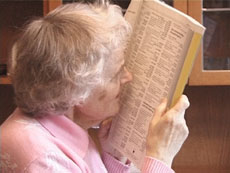
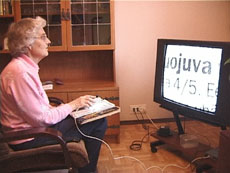
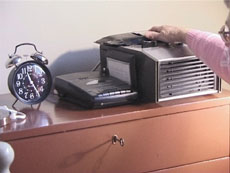
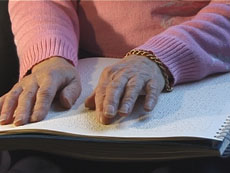
Figure 16b. Macular degeneration with decrease in visual acuity causes need of stronger and stronger reading glasses. If the person is myopic, reading without glasses or with a close circuit TV reading aid may be good techniques. Use of talking books and braille are options when reading print becomes too slow.
Macular degeneration makes lipreading and reading of finger alphabet difficult. A person with macular degeneration should remember to ask people to talk more slowly, to pronounce words carefully and to stand facing the light. Then it would be easier to see the lips. It would be still easier if people who talk to the hearing impaired use a contrast pen to accentuate the lip margins. There are also brown contrast pens so one does not need to use lipstick and a red contrast pen.
Peripheral retinal degenerations usually start in the midperipheral retina, in an area surrounding the central retina. Later during the course of the changes peripheral retina may loose its function. Eventually only the central retina functions, the person has tunnel vision. The first symptom is often night blindness, difficulties seeing in twilight and in the dark.
Since it is difficult to explain how one sees when vision has become abnormal, I have written a list of questions. Interpreters have found them important because they are often used during a visual assessment. This list may help the interpreters and the patients to be better prepared for the visit to the doctor's office.
Questions:
1. Vision in twilight.
- Do you see poorly in twilight and at night?
- If you wait in the dark, do you start seeing better?
- How long a time do you have to wait?
- When you go into a dark room, does your field of vision become smaller?
- There is often very little light in the trains and busses. Is it difficult to see on trains and busses?
- Is it difficult to go from a brightly lighted area to a place in shadow?
- When you go into a store, do you have to stop at the door and wait for a while before you start seeing in the store?
- If the sun is shining into your eyes, does your vision become much worse?
- Does the sun dazzle you for a long time? How long?
- Does bright light cause pain in your eyes?
- Do you use sunglasses? Goggles?
- Do you have several different sunglasses? How many?
- Do you bump into people even if you are wearing your sunglasses in bright light?
- Do car head lights dazzle you?
- Is it difficult to move in places where people walk close by?
- If you walk in a place where the wind moves branches of bushes and trees, does the movement of the branches bother you?
- If you turn your head quickly, does it bother your vision?
- If movements disturb your vision, what happens to your vision when it becomes disturbed? How does it change?
- Can you see the curb?
- Can you see the stairs when you walk downstairs?
- Do you see the poles of traffic signs in time?
- Is it difficult to see light coloured food on a white plate?
- Has it become more difficult to read lips and fingerspelling?
- Is the newspaper text difficult to read because of the light ink in the print?
- Is it uncomfortable to sit facing a window?
- Do you find small local lights, like candles, disturbing?
- When you read, how do you want to arrange the lights in the room and the reading light?
- What colour of light is most comfortable? Do you use filter glasses when reading?
- Does extra light make reading small texts easier?
- Look around at home and think which lights should be moved to another place? Where you would like to have more light?
- Are the street lights strong enough? Do you need a flash light?
- How large an area do you see in front of you?
- Do small objects disappear from your vision and pop up after a while?
- Since you have loss of vision in parts of your field of vision, have you sometimes misunderstood a situation?
- How many letters do you see clearly without moving your eyes?
(This is asked when you read different sizes of test texts. Look at several different texts at home in different illuminations and at different distances to find out what you find best. Write down the reading distances and bring the texts with you.) - When you read, can parts of the letters disappear?
- If you use sign language, does the person signing have to go further away to be seen?
- How much of the interpreter do you see without moving your eyes around?
- Is there flickering of the picture (image) in any part of your field of vision?
- Do you see lights moving around (near) the blind areas of your field of vision?
- Are there any other lights moving in the visual field? How do they look like?
- If you cough or laugh, does the image change?
- If you see lights moving across the visual field, do you see your surroundings as through a frosted glass? Or does the image disappear? Do straight lines become different? How?
- When did you notice the first changes in your vision? Before school age, at school, after school?
- How rapidly did the changes develop then?
- Has there been any change in your vision during the last year? During last five years?
- Has there ever been a period of very rapid progression of the changes? When? How did your vision change then?
- Have colours become different?
- Do you have difficulties with any colours?
- Has your reading speed changed? How much? When?
- Do you have any pain in your eyes?
- Do you have several pairs of glasses? ( If you do, please, bring them all to the office. Bring also all other devices.)
- Do you have tinted glasses? Sunglasses?
- Do you use magnifying lens(es)?
- Do you have a telescope?
- Do you use any other visual devices?
- Which visual devices would you like to try this time?
It is often difficult to be sure that one has understood the question correctly. Do not hesitate asking the doctor whether (s)he could ask the same question using other words.
In order to understand what might happen in different diseases, it is good to know more about the retina.
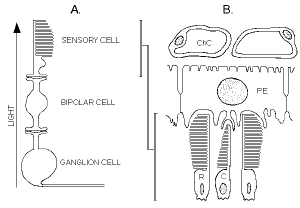
Fig.16c. Structure of the retina.
A.The basic organisation of the retina. The inner layers of the retina (ganglion cells and bipolar cells) are transparent. The light traverses the inner layers and is absorbed in the outer segments of the sensory cells. When the light is absorbed there are chemical and electrical changes in the sensory cells. These changes are transmitted to the bipolar cells and from there to ganglion cells, that in turn send the information as an electric impulse into the brain. B.Sensory cells, rods (R) and cones (C), pigment epithelium (PE) and choriocapillaris (ChC). The outer segments of the sensory cells (the striped part) have lamellae. The visual pigment that absorbs the light, is located on these lamellae.
Although the word retinitis means inflammation, retinitis pigmentosa-disease is not an inflammation but a degeneration of the retina.
When the cone cells are affected, loss of visual field starts as small patches around the central vision. These patches grow slowly to form ring scotoma around the central vision. Then the person sees within the central field and in the peripheral vision but not in between. It is often difficult to understand such vision. Especially children may be puzzled by small objects disappearing and reappearing. Children sometimes believe that someone is teasing them and making things to disappear.

|
Fig 17. Changes in the visual field start as small patches. They are not seen white or black, but "empty". When they are small they are difficult to notice. The patches grow slowly and form a ring, ring scotoma. Later only the central visual field functions, the person has tubular field, tunnel vision. |
When the peripheral vision disappears the person may have a small central visual field called tunnel vision.
Changes in the retinal cells often cause peculiar lights, illusory lights, to appear. To many retinitis pigmentosa patients these lights look like shiny sausage-formed balloons and appear at the edge of the functioning central field. If a child sees such lights he/she may not understand why other persons do not want to look at the lights. All children who mention seeing lights that are not there should be carefully examined by an ophthalmologist.
Some persons with retinitis pigmentosa see wiggling lights going across the visual field. The different lights may apppear at different ages in different individuals. Not all persons with retinitis pigmentosa see these illusory lights.
Sometimes the light phenomena are seen after coughing, sneezing or laughing. The visual field may also become much smaller for a while and slowly increase to its usual size.
There are half a dozen pictures related to retinitis pigmentosa in the German text Funktionales Gesichtsfeld and in the corresponding English text Functional Field of Vision.
Nearly one half of all persons with retinitis pigmentosa and many other visually impaired are disturbed by photophobia. Light falling directly into the eyes causes dazzle. Light coloured surfaces may also reflect enough to disturb vision.
Decreased contrast sensitivity is a common feature of retinitis pigmentosa and several other eye diseases. It means that the person does not see faint shadows, (s)he needs high contrast in order to see. Lips are easier to see if the person uses a contrast pen or lipstick.
Decreased contrast sensitivity can be a problem in play situations. One of my young patients was left alone to ski in a birch forest on a cloudy winter afternoon. The contrasts between the white birch trees, cloudy sky and newly fallen snow were very low. The child could not find his way out of the forest. Persons with limited vision should never be left alone in places where they might not find their way.
Sighted Blind
We call RP-patients with tunnel vision "sighted blind" because they behave as if they were both sighted and blind. They move about using the white cane to find their way into the bus or train and sit down and start reading their newspaper without glasses. Quite often the people around the RP-patient react negatively, sometimes hostily, because they cannot understand why a "blind" person can read small text. We should explain them that there are people who need to use the white cane because of small field but who can read print.
If the visual field is limited, the further away one looks, the more one sees. Many RP-patients have reported that they do not experience particular difficulties when driving. As one of them put it, "It is not difficult to drive, but it is difficult to find the car in the parking lot". The RP-patients may be unaware of the dangers they come close to in trafic. Every person who has changes in his/her visual field should let his/her driving capability be tested at regular interwalls.